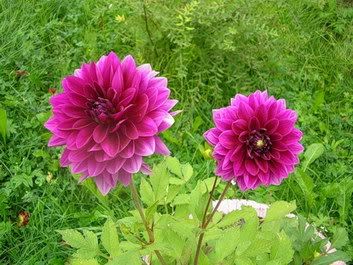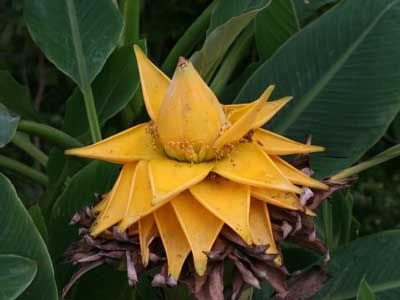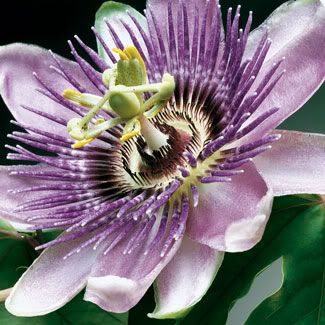I have picked out 3 plants in particular which I believe it could be agreed upon produce astonishing flowers. They come from all parts of the world and need different requirements in different humidity, soil, sun exposure, and air quality, so the advice I give is strictly from the vantage point of Western Garden, in an inland valley, or one whose weather is most influenced by the interior of the continent rather than offshore.
#3- Dahlias
Although these flowers are not hard to find and may seem ordinary, they can be far from it. Though I have never seen it, these bold flowers can grow as wide as 15 inches across in some species, and come in a wide variety of colors, and stamen/ovum colors. The leaves can also be different colors. Working at the Do It Center in the nursery, The largest Dahlia I have ever encountered was 13 inches across. Normally to get flowers these big it is necessary to throw a huge amount of nutrients (especially nitrogen) on them to get them to flower, but it is an art to get them to produce a few huge flowers, as supposed to a moderate amount of medium flowers.
Normally these flowers are bought when they first come in, but sometimes they stay in the nursery a year until someone decides they see a flower and they want it. To get them to continue blooming it is necessary to help them by carefully watering them, and making sure they have sufficient foliage to support the flower (nutrient-wise), then 2-3 weeks before it is time for them to bloom (late spring to end of summer) I will give them nitrogen and iron, over a long period of time to help them develop the flowers. It should be noted they need to be in the ground or else they are very stressed under transplant conditions, and should wait till next year. When flowers fall over and can not be secured, they should be cut off and floated on water or discarded. After the flowering season is over, they should be given ½ as much water and all the flowers cut off to prevent stressing the plant to support the giant limb. I know the least about these in this list because I have never owned one, but I do take care of them in the nursery.
#2 – Musa Lasiocarpa (Chineese Yellow Banana)
This is truly an exotic plant, and may require a green house or covered 4 walled courtyard to grow. This is not a true banana but a true relative. When it gets to the right time, the flowers starts to develop, and from that point, none of the leaves develop anymore. It takes a full year for the flower to develop, and the leaves slowly die off until all that is left is the bud at the top of the plant, usually at the beginning of the summer. Then a magnificent 8 inch yellow artichoke looking flower opens up, and remains until the end of summer. At the same time this is happening, many leaflets (small plants) may start forming and spreading from the base of the plant. These are new plants that can be kept in place or transplanted. I believe the flower smells like banana, but I have yet to know, since the one at the house has yet to open. At this point, the flower should be cut from the trunk at the end of the season, The original trunk should be cut down, and time should be allowed for the sprout to start the process all over again.
This flower should not be picked. It is beauty in the idea in the beholder, because it is mounted on a dying trunk. This plant needs shade in hot regions like mine, and very fast draining soil. It is also beneficial to have many worms at the bottom to ensure good drainage. When I planted mine, I also had added perilite and sand, a very small amount of 15-30-15 to tempt the roots out, and the original soil. It is also beneficial to break the root ball from the store when planting, and to make sure the plant never gets direct sun light when it is extremely hot outside. The closer you have it to a house the better it may due, as the house will support it in the wind, and the temperature is slower to change around the house.
#1 Passiflora Alacaeruela (Passion Flower)
My favorite flower, I have been raising this vine for well over a year now, and it took off after I planted it in the right location. In the hottest regions, this plant needs shade at least half the day, and it is best not to have intense evening light when the day is at it’s hottest. Overall I would worry more about the vine freezing then about it burning in the sun. It is advisable to mimic the location it was grown in the store it is bought from. But what makes this flower so amazing is how hard it seems to obtain in certain regions, and how alien the flower looks. The flower is 3-4 inches across, the outside petals are greenish purple with 10 petals alternating purple and white. The stamens arrange in a circle like a hub sitting a centimeter away from the petals, and the ovum comes out the middle 2 inches, spreading into 2 level at the top. The bottom level has 5 extending parts, and the top has 3. The top of the middle section looks almost like the hook on a grappling gun, and it makes for arguably one of the most bizarre flowers in nature. The reason that very few people posses these plants is cause cooped up on a stick, the hardly flower. They are hard to obtain, because most people don’t know about them or buy them, so very few nurseries will spend the energy to grow them. Considering what you get they are fairly inexpensive. The leaves of this plant are three lobed, like the boy scout emblem. They are an amazing highly adaptive plant with a very specific niche. They support a particular type of butterfly, which lays its eggs on a leaf, and then eats the leaf, gets wrapped up in a chrysalis. Then the butterfly will pollinate the plant.
The best plan is to set an area up well in advance for this plant. It likes gradual change. It should be shaded a couple of hours till gradually the light reaches it’s peak (noon), and then should get full sun, finally allowing the sun to filter out gradually for the rest of the day. This is how I have it, so I assume it should work for most in Southern California as well. My plant grew around the courtyard to a length of near twenty five feet. The soil is very important. NO CLAY, planting this plant in excellent draining soil is crucial to its survival. I dug out an area 5 to 6 X the area of the roots in width, and mixed in a lot of potting soil and sand, with ample perilite, and a small amount of 15-30-15 all purpose, with a fair amount of ironite to support the leaves and photosynthesis. It should be noted I keep this plant in close proximity to a sprinkler, and it is near a giant bird of paradise, and a majestic fern, next to a 300 + gallon pond. This may keep the humidity in the area slightly higher, and give certain parts shade more at certain times. Once the plant is established it is hardy as long as it is fed once a year, and does not freeze. The vine should also be heavily trimmed to keep it from overexerting itself, and waisting energy. As soon as I was aware of a long overgrown 25 foot vine, I cut it off.
Note: This may not be the best method for growing the above plants in your area. Always get an experts advice before proceeding with these plants. The Western Garden Book edited by sunset is like the bible of plants, and contains an alphabetical list by genus of all the plants grown in the west.
Tuesday, June 23, 2009
Guest Blogger: Passionate Bold Striking Flora
Jeffrey Parker is a budding scientist currently working on obtaining a degree in molecular and cellular biology. In his free time he enjoys cultivating a passion for flowers, particularly those of the exotic variety. Currently in his own home, Jeffrey has a Chinese Yellow Banana, Passion Flower, Trailing Red Spider Fuchsia, Upright Jingle Bells Fuchsia, and would enjoy maintaining exotic orchids if his budget allowed for it. Here, he shares with us three choice exotic flowers and how you can grow them in your own home! (Images were obtained by Jeffrey via Google Images).
Labels:
guest blogger,
Jeff,
Photos
Subscribe to:
Post Comments (Atom)



I love these flowers. So interesting. I don't do much gardening, though, everything I've ever planted usually never grew too well for me. I do have bamboo in my room, though. Lol. No tending required, simple.
ReplyDelete